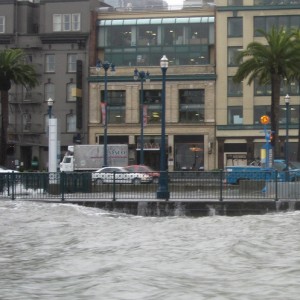The report puts a lot of focus on heat waves, which, if you live in San Francisco like me, may seem improbable. But Tam says it's exactly places like San Francisco that are most vulnerable to increased heat because we're not prepared for it. (How many people here do you know with air conditioning?)
The report says that by 2100, the Bay Area may experience between 74 and 90 days above 81 degrees Fahrenheit per year. Throughout the 20th century, the region averaged about 12. An increase like that means greater risk for heat-related illnesses and some infectious diseases, as well as poorer air quality. To address this, SPUR recommends communities identify vulnerable populations, reduce the "urban heat island effect" by promoting white roofs and urban forestry, building communications and public warning systems, and developing robust "heat response plans" and air quality monitoring programs.
Will Travis, the executive director of the San Francisco Bay Conservation and Development Commission (BCDC) and a SPUR board member, said that cash-strapped cities and towns have been "reticent" to deal with climate change adaptation because it can seem like a problem of the future. But communities are going to have to act soon to avoid a crisis that's both environmental and economic, he said.
“Our region is not going to be able to remain competitive and attract the capital we need to make our innovative economy grow if we don’t address this problem right now," said Travis.
According to BCDC, the Bay Area may see 55 inches of sea level rise by 2100. The SPUR report says that means more than 186 miles of major roads (including I-80, I-880, U.S. 101, Highway 37, I-680, and Highway 12), more than 105 miles of regional rail track, and 93% of Oakland Airport and SFO property will be vulnerable to flooding.
“That transportation infrastructure is the lifeblood of what makes our economy work," said Travis. "We need that mobility, so we’re going to have to be retrofitting those facilities to make sure that they don’t go underwater."
The report recommends agencies conduct a comprehensive transportation vulnerability assessment, design resilient new transportation projects, and develop emergency transportation alternatives for cases of extreme weather events.
The report is dense and detailed, and it's a sobering look at exactly how much needs to be done to prepare for what many state and regional agencies agree is likely on its way. Odds are, none of this will be cheap. And yet, according to SPUR's Laura Tam, beginning to deal with climate change impacts now could save money as well as lives.
"If we don't start planning ahead and preparing, we will end up dealing with crises that emerge as emergencies, and we don't want to be in the position of having to respond to climate emergencies," she said. "We want to know what to expect, and be prepared, so that the least amount of property is damaged and the least amount of people suffer."
Gretchen Weber is the Multimedia Producer of Climate Watch.
